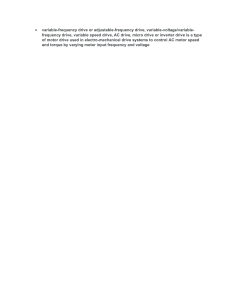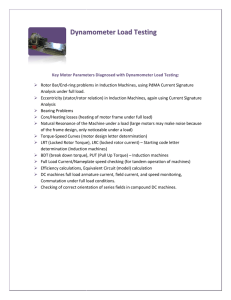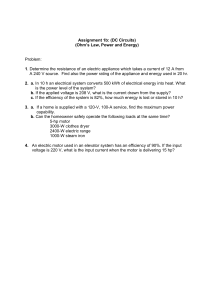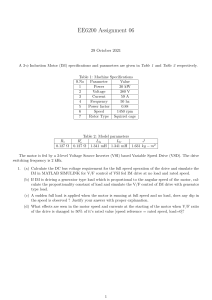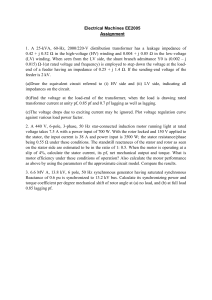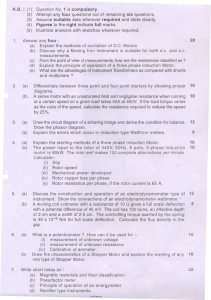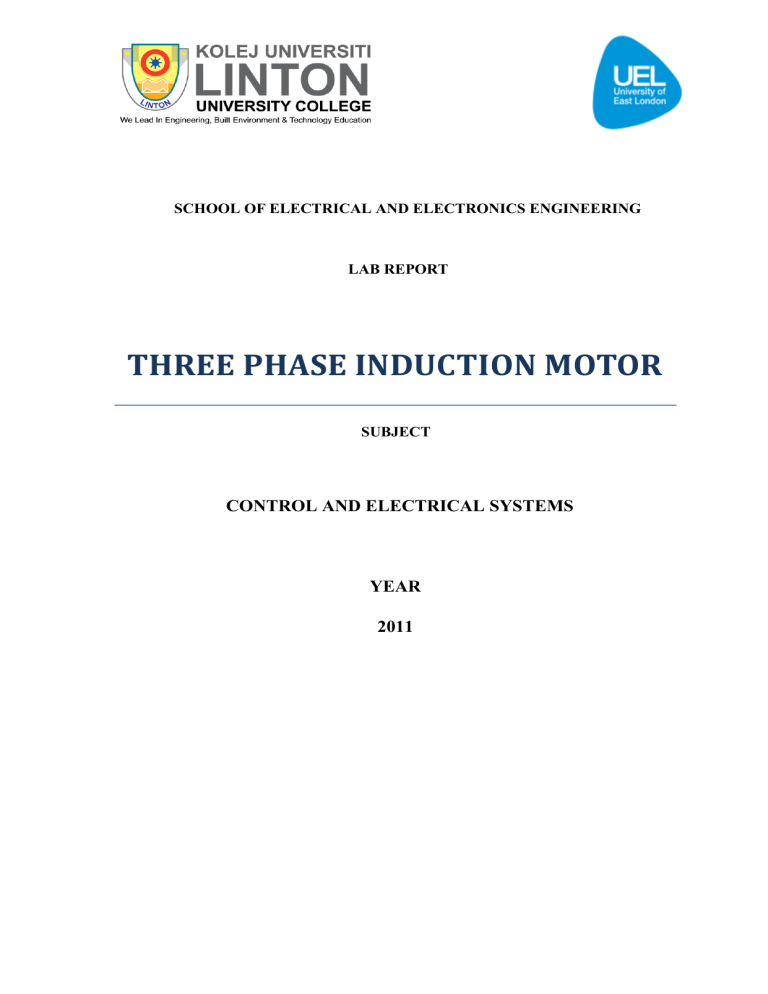
SCHOOL OF ELECTRICAL AND ELECTRONICS ENGINEERING LAB REPORT THREE PHASE INDUCTION MOTOR SUBJECT CONTROL AND ELECTRICAL SYSTEMS YEAR 2011 EXPERIMENT 1 STUDY OF CHARACTERISTICS OF THREE PHASE INDUCTION MOTOR Aim To study the no load characteristics of three phase induction motor Objectives i) To investigate the no load characteristic of a three phase induction motor. ii) To study the relation between the current and the voltage of three phase induction motor in both star and delta connection. iii) To modify the sense of rotation. Name plate details 3 phase induction motor Rated voltage = 41.5 V.AC Rated power = 50 W Rated current = 1.4 A Rated speed = 1320 RPM 2 Introduction Induction motor is a rotating electrical machine. Induction motor can be operated by one phase alternating voltage source and by three phase alternating voltage source. The induction motor consists of ‘Stator’ and ‘Rotor’, stationary part and rotational part, respectively. The rotor consists of cylindrical iron that laminated with copper strips. The stator consists of a three phase windings that are placed on the slots of laminated core, these windings apart by 120 degrees. These windings can be connected be configured in a star connection or in delta connection. 3 i) Star connection Circuit diagram Figure 1.0: Star connection diagram Procedure Connections were mad as shown in (Figure 1.0). The AC supply voltage adjusted to minimum and the maximum rated voltage of the motor is noted. The AC supply is turned on and the voltage increased to the maximum voltage rated for the motor which is 41.5 volts. I been ware to not exceed the limit. The no load current of the maximum rated voltage for the motor is tabulated. The voltage is decreased gradually by 5 volts and the no loads current is tabulated and repeat by decreasing the voltage and tabulate the no load current and voltage. When all readings are tabulated I decreased the AC supply voltage to 0 volts and off the supply. The no load characteristics of the induction motor is sketched. 4 Experimental results of star connection Table 1.0: Star connection IV table SI Star connection No. Voltage Current 1 41.5 0.4 2 35 0.35 3 30 0.3 4 25 0.25 5 20 0.2 6 15 0.15 7 10 0.1 Star connection IV characteristics graph 0.45 0.4 Current (A) 0.35 0.3 0.25 0.2 0.15 0.1 0.05 0 0 10 20 30 40 50 Voltage (V) Figure 1.1: Star connection I versus V graph 5 ii) Delta connection Circuit diagram Figure 1.2: Delta connection diagram Procedure Connections were mad as shown in (Figure 1.2). The AC supply voltage adjusted to minimum and the maximum rated voltage of the motor is noted. The AC supply is turned on and the voltage increased to the maximum voltage rated for the motor which is 41.5 volts. I been ware to not exceed the limit. The no load current of the maximum rated voltage for the motor is tabulated. The voltage is decreased gradually by 5 volts and the no loads current is tabulated and repeat by decreasing the voltage and tabulate the no load current and voltage. When all readings are tabulated the AC supply voltage is decreased to 0 volt and off the supply. The no load characteristics of the induction motor is sketched. 6 Experimental results of delta connection: Figure 1.2: Delta connection IV table SI Star connection No. Voltage Current 1 41.5 1.4 2 30 0.9 3 25 0.7 4 20 0.6 5 15 0.5 6 10 0.4 7 5 0.3 . Delta connection IV characteristics graph 1.6 1.4 Current (A) 1.2 1 0.8 0.6 0.4 0.2 0 0 5 10 15 20 25 30 35 40 45 Voltage (V) Figure 1.2: Delta connection I versus V graph 7 Analysis 1. Difference in phase and line current in star and delta connections. IP = IL Figure 1.3: Star connection (Figure 1.3) shows that for a star connected loads the potential difference across any load is the potential difference between the phase line connected to it and the neutral, however the line voltage will be greater than this because it is the potential difference between two phase lines. The current through the load will be the same as the line current. Thus for balanced star connected loads:ELine = √3EPhase And ILine = IPhase 8 √3 IP = IL Figure 1.4: Delta connection (Figure 1.4) shows that for delta connected systems of loads the phase voltage is equal to the difference between two lines. The phase current for each load is coming from two lines (because each load is connected to two lines) and will be more than the line current. Thus for delta connected loads:- ELine = EPhase And ILine = √3 IPhase 2. Reasons for the motor to change the rotation direction. When exchanging two phases the motor rotation direction changes due to the change in flux direction produced by the windings in the motor. 9 3. Explanation on how rotating magnetic field is produced in the stator of a three phase induction motor. The premise for motor operation is that if you can create a rotating magnetic field in the stator of the motor, it will induce a voltage in the armature that will have magnetic properties causing it to 'chase' the field in the stator. This premise applies to AC motors that employ a squirrel cage rotor, and it is probably the most simple and basic of all motor designs. The three phase motor is widely used in industry because of its low maintenance characteristics. Due to the nature of three phase power, creating a rotating magnetic field in the stator of this motor is simple and straight forward. The stator windings are arranged on the stator poles in a way that results in magnetic flux lines that seem to rotate where , the number of pole pairs must be the same as or a multiple of the number of phases in the applied voltage. The poles must then be displaced from each other by an angle equal to the phase angle between the individual phases of the applied voltage and the strength of the magnetic field changes, as the current flow in the coils of wire around the stator poles change. Just as the current in the field windings rise and fall 120 electrical degrees apart, so does the resulting magnetic field on the pole. 10 4. Safety requirements when dealing with high power rated three phase induction motor. Safety is needed at a time of installation, after the installation and at the time of servicing. Safety requirement at time of installation: Check for any damage which may have been incurred in handling. The motor shaft should turn freely by hand. Repair or replace any loose or broken parts before attempting to use the motor. Check to be sure that motor has not been exposed to dirt, grit, or excessive moisture in shipment or storage before installation. Measure insulation resistance. Clean and dry the windings as required. Never start a motor which has been wet without having it thoroughly dried. Safety requirement after installation: Ensure that safety guards are in use. Keep hands and clothing away from moving parts. Never attempt to measure the temperature rise of a motor by touch. Temperature rise must be measured by thermometer, resistance, imbedded detector, or thermocouple. 11 Safety requirement at time of maintenance: All power sources to the motor and to the accessory devices should be deenergized and disconnected and all rotating parts should be at standstill. Suitable protection must be used when working near machinery with high noise levels. Safeguard or protective devices must not be by-passed or rendered inoperative. The frame of this machine must be grounded in accordance with the National Electric Code and applicable local codes. A suitable enclosure should be provided to prevent access to the motor by other than authorized personnel. Extra caution should be observed around motors that are automatically or have automatic re-setting relays as they may restart unexpectedly. Shaft key must be fully captive or removed before motor is started. Provide proper safeguards for personnel against possible failure of motormounted brake, particularly on applications involving overhauling loads. 12 Conclusion All in all, the three phase synchronous induction machine consist of winding either connected in delta configuration or Star configuration but for each configuration the relation between the phase and line in voltage and current varies. And the rotating direction depends on the flux produced by the windings. 13 References i. Donald G. Beaty, H. Wayne Fink, (1978). Standard Handbook for Electrical Engineers. 11th Edition. The Kingsport Press. ii. Galileo Ferraris, (1885). Electromagnetic rotation with an alternating current, Electrican, Vol 36. p 360-75. iii. Benjamin Franklin Bailey, (1911). The induction motor. McGraw-Hill. 14 EXPERIMENT 2 LOAD TEST ON THREE PHASE INDUCTION MOTOR Aim The load test on 3-phase induction motor is performed to obtain its various characteristics including efficiency. Objectives i) To investigate the performance characteristics of three phase Induction motor by applying eddy current load ii) To determine the efficiency of a three phase Induction motor Name plate 3 phase induction motor Rated voltage = 41.5 V.AC Rated power = 50 W Rated current = 1.9 A Rated speed = 1320 RPM 15 Circuit Diagram Stator star connected 3-phase winding 3 phase 41.5V 50Hz AC supply Eddy current load 3 phase squirrel cage induction Eddy current load motor Figure 2.0: Motor to Eddy current load connection 16 Procedure Connections were mad as shown in (Figure 2.0). The AC supply voltage adjusted to minimum and the maximum rated voltage of the motor is noted. The AC supply is turned on and the voltage increased to the maximum voltage rated for the motor which is 41.5 volts. I been ware to not exceed the limit. The no load current, power factor, power and torque of the maximum rated voltage for the motor are tabulated. Eddy current load was connected to the induction motor and supplied by a DC supply. The Eddy current load is increased gradually by increasing the DC supply. The load current, power factor, power and torque are tabulated for the resultant until the load current reaches the maximum rated current. When all readings are tabulated the AC and DC supplies are decreased to 0 volt and off the supplies. The load characteristic of the induction motor is sketched. Experimental results Table 2.0: Tabulated experimental results V1 V2 I1 I2 P.F1 P.F2 T N 41.3 V 41.5 V 0.5 A 0.5 A 0.995 0.82 0 1412.5 40.6 V 40.8 V 0.6 A 0.5 A 0.995 0.81 0.114 1389 38.8 V 39.1 V 0.7 A 0.6 A 0.995 0.78 0.1444 1332.4 35.9 v 36.2 V 0.8 A 0.8 A 0.998 0.74 0.2052 1223.1 35.5 V 35.8 V 0.9 A 0.8 A 0.999 0.72 0.2584 1191.1 34.4 V 34.7 V 1A 0.9 A 0.999 0.69 0.3192 1082.3 17 Analysis 1. Determine the input power, output power and efficiency. i. For V1 = 41.3, I1 = 0.5 and Cos1 = 0.995 W1 = V1 x I1 x Cos1 = (41.3) (0.5) (0.995) = 20.55W For V2 = 41.5, I2 = 0.5 and Cos2 = 0.82 W2 Power Input = V2 x I2 x Cos2 = (41.5) (0.5) (0.82) = 17.02W = W1 + W2 = 20.55 + 17.02 = 37.57W Power output = T = 0 = 0W Efficiency% = x 100 18 = = x 100 0% Synchronous speed (Ns) = Thus, slip = ii. = = = 1500rpm = 0.06 For V1 = 40.6, I1 = 0.6 And Cos1 = 0.995 W1 = V1 x I1 x Cos1 = (40.6) (0.6) (0.995) = 24.24W For V2 = 40.8, I2 = 0.5 and Cos2 = 0.81 W2 Power Input = V2 x I2 x Cos2 = (40.8) (0.5) (0.81) = 16.52W = W1 + W2 = 24.24 + 16.52 = 40W 19 Power output = Efficiency% T = 0.0114 = 16.58W = x 100 = = Slip = iii. x 100 40.68% = = 0.074 For V1 = 38.8, I1 = 0.7 and Cos1 = 0.995 W1 = V1 x I1 x Cos1 = (38.8) (0.7) (0.995) = 27.02W For V2 = 39.1, I2 = 0.6 and Cos2 = 0.78 W2 = V2 x I2 x Cos2 = (39.1) (0.6) (0.78) = 18.3W 20 Power Input = W1 + W2 = 27.02 + 18.3 = 45.32W Power output = Efficiency% T = 0.1444 = 20.15W = x 100 = = slip = iv. x 100 44.46% = = 0.112 For V1 = 35.9, I1 = 0.8 and Cos1 = 0.998 W1 = V1 x I1 x Cos1 = (35.9) (0.8) (0.998) = 28.66W For V2 = 36.2, I2 = 0.8and Cos2 = 0.74 21 W2 Power Input = V2 x I2 x Cos2 = (36.2) (0.8) (0.74) = 21.43W = W1 + W2 = 28.66 + 21.43 = 50.09W Power output = Efficiency% T = 0.2052 = 26.3W = x 100 = = Slip = x 100 52.5% = = 0.184 22 v. For V1 = 35.5, I1 = 0.9 and Cos1 = 0.999 W1 = V1 x I1 x Cos1 = (35.5) (0.9) (0.999) = 31.79W For V2 = 35.8, I2 = 0.8 W2 Power Input = V2 x I2 x Cos2 = (35.8) (0.8) (0.72) = 20.62W = W1 + W2 = 31.79 + 20.62 = 52.41W Power output = Efficiency% = 0.2548 = 32.23W = = vi. Cos2 = 0.72 T x 100 = Slip = & x 100 61.5% = = 0.206 For V1 = 34.4, I1 = 1 and Cos1 = 0.999 23 W1 = V1 x I1 x Cos1 = (34.4) (1) (0.999) = 34.37W For V2 = 34.7, I2 = 0.9 and Cos2 = 0.69 W2 = V2 x I2 x Cos2 = (34.7) (0.9) (0.69) = 21.55W Power Input = = 34.37 + 21.55 = 55.92W Power output = Efficiency% W1 + W2 T = 0.3192 = 36.18W = x 100 = = Slip = x 100 64.7% = = 0.28 24 The calculated input power, output power and efficiency are tabulated as shown in (Table 1.1). Table 2.1: Input power, output power and efficiency W1 W2 20.55w 17.02w 37.57 Efficiency 0 14.9% 24.24w 16.52w 40.76 16.58 40.68% 27.02w 18.30w 45.32 20.15 44.46% 28.66w 21.43w 50.09 26.3 52.5% 31.79w 20.62w 52.41 32.23 61.5% 34.37w 21.55w 55.92 36.18 64.7% 1. Can the speed of the induction motor be equal to synchronous speed? At idle the rotor almost reaches the synchronous speed of the rotary field, since only a small counter-torque (no-load losses) is present. If it were to turn exactly synchronously, voltage would no longer be induced, current would cease to flow, and there would no longer be any torque. During operation the speed of the rotor drops to the load speed n. The difference between the synchronous speed and the load speed is called slip s. Based on this loaddependent slip s, the voltage induced in the rotor winding changes, which in turn changes the rotor current and also the torque T. As slip s increases, the rotor current and the torque rise. And that resultant drops in speed. 25 3) Construction of squirrel cage rotor and slip ring rotor. The squirrel cage rotor consists of a slotted cylindrical rotor core sheet package with aluminium bars which are joined at the front by rings to form a closed cage. The rotor of three-phase induction motors sometimes is also referred to as an anchor. The reason for this name is the anchor shape of the rotors used in very early electrical devices. In electrical equipment the anchor's winding would be induced by the magnetic field, whereas the rotor takes this role in three-phase induction motors as shown in (Figure 2.1). Figure 2.1: Squirrel cage rotor 26 The slip ring induction motor rotor has similar construction as the squirrel cage rotor, unless it consists of slip rings and it has three carbon brushes connected externally to a 3-phase start connected rheostat as shown in (Figure 2.2). Thus these slip ring and external slip rings rheostat makes the slip ring induction motors possible to add external resistance to the rotor circuit, thus enabling them to have a higher resistance during starting and thus higher starting torque. When running during normal condition, the slip rings are automatically short-circuited by means of a metal collar, which is pushed along the shaft, thus making the three rings touching each other. Also, the brushes are automatically lifted from the slip-rings to avoid frictional losses, wear and tear. Hence, under normal running conditions, the wound rotor is acting as same as the squirrel cage rotor. Rotor windings Carbon brushes Slip rings Rheostat Figure 2.2: Slip ring rotor 27 4) Sketching torque, speed and slip characteristics of the induction motor Figure 2.3: Slip and Speed versus torque graph 28 5) Sketching torque, speed and slip characteristics of the induction motor by using MATLAB software. MATLAB commands is as shown in (Figure 2.4):- Figure 2.4: MATLAB commands The plotted slip versus torque graph is shown in (Figure 2.5) and the speed versus torque graph is as shown in (Figure 2.6). 29 Figure 2.5: Slip vs torque graph by using MATLAB Figure 2.6: Speed vs torque graph by using MATLAB 30 Conclusion According to the plotted graphs we observe that the slip having a proportional relation with the torque as the torque is increasing the slip is increasing as well, while the relation between the torque and speed is non-proportional as the speed is increasing the torque is decreasing. 31 References i. B.L. Theraja, (2008). Textbook of Electrical Technology. Chand (S.) & Co Ltd ,India. ii. Edward Hughes, (2001). Electrical & Electronic Technology. 8th Edition. Longman Group United Kingdom. iii. William D Stevenson, (1975). Elements of power system analysis (McGraw-Hill electrical and electronic engineering series). 3rd Edition. McGraw-Hill. 32
